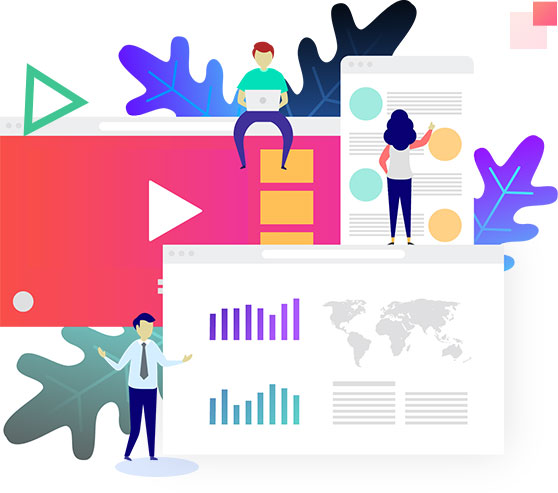Why Is Website Optimization Important?
Website optimization is important because it lets your website visitors be more effective with their website visits. Every visitor comes to your site hoping to answer a question, find a solution to their dilemma, or complete one or another mission. Through designing your website, you make these activities simpler for your website users.
For example, if you’re an ecommerce website selling shoes, you can optimise your website to maximise the amount of transactions made by visitors to your website. You can do so by optimising conversion rate, which focuses on regularly checking different parts of your website to increase so conversion rate.
By optimising your website, your site becomes more successful for your company. A more efficient website can improve revenue for your company through new sales or leads, lowering costs , increasing conversion levels on current marketing spending, or lowering customer service needs through clearer knowledge and transparency for visitors with questions.
Why should you optimize your site technically?
Google and other search engines want to show their search results to their users. Google’s robots crawl and evaluate web pages on multiple factors. Some factors are based on user experience, like how quickly a page loads. Other factors help search engine robots grasp your pages. Structured data, among others, does this. By enhancing technical aspects, you help search engines crawl and understand your site. If you do this well, you may receive higher rankings or even rich results.
It also works the other way around: if you make severe technical errors on your web, they can cost you. You wouldn’t be the first to completely stop search engines from browsing your site by inadvertently adding a trailing slash to your robots.txt file.
But it’s a misconception you should focus on website technical details just to please search engines. A website should work well — fast, clear , and easy to use — for your users first. Fortunately, creating a strong technical foundation often coincides with better user and search engine experience.
6 Essential Website Optimization Strategies
1. Optimizing the Mobile Experience
It’s not enough to have a website that looks fantastic on laptops and desktop computers. To excel in the online marketplace, you must also concentrate on your site’s mobile experience. Most traffic in 2018 (52.2 percent) was mobile. Most Google searches now happen on smartphones. In Q3 2019, 64% of Google searches[5] were on mobile. Google has now moved to mobile-first indexing, where they mainly index and rate the web sites. So any problems will cost you not only possible mobile conversions, but the chance to rank highly for specific search words.
So, for example, Google’s Mobile-Friendly Test is the first thing you want to do. Fix any obvious problems the check appears. You can also check all pages on the most common phone models to make sure it fits each screen size. You can do this with the Chrome Developer Tools toolbar. You can view your website in different screen windows. Also, take action to address any future problems. You want easy time for mobile users on your app. You should make sure: you don’t have screen popups or interstitials. Site loads fast & correctly. Reading the text is simple. All contents are available. Scaled-down photos are still legible. The platform is conveniently navigable. When you cover these basics, both consumers and search engines will praise you.
2. Improving Page Speed
Users don’t like sitting and waiting while a site loads. A 5-second load leads to a bounce rate of 38%, and the longer it takes, the higher it becomes. Creating a fast-loading website is the first aspect of successful user experience. Page speed is also an official Google ranking factor, and can affect your SEO directly. You can use a free online tool like Pingdom Website Speed Test or Google’s Pagespeed Insights to find out how good your site is, and possible bottlenecks and issues. This will rate the website, count all HTTP requests, categorise them, and highlight what you should fix.
Some popular issues are uncompressed JS and CSS files, no CDN, no CMS-powered site caching, and huge, unoptimized image files. Compression and caching problems, and lack of CDN, can be easily addressed for your CMS with plugins or extension. Accessible image compression software such as Smush, kraken.io, Cloudinary, or ImageKit can optimise images. It can take a substantial expenditure in time or resources, but it’s worth every millisecond you shave off. A low-cost , low-quality shared hosting plan can also cause slow page loading times. So, if your page still loads slowly after you’ve scored 90 + on page speed software, you need to update to a better programme.
3. Search Engine Optimization
4. Tailoring Website Copy to Drive Conversion
Your website’s words matter more than you thought. Layout, photos, usability, page speed are all main factors, but words dominate your post. And while words are the simplest thing to alter, they can be the strongest. Case studies also show web copy power. In one case, adding one word to a headline increased conversions by 89.97%. So don’t rush your stuff. You want a clear guide to the conversion action you want them to take on every link. Not only do you understand simple copywriting methods, but also your customer base.
When you don’t understand your visitors’ issues, wishes, and questions, you can’t build a path that will lead them to the destination you want. Analyze in-depth user data such as heatmaps to get to know the consumer experience and explore their reservations and what inspired them to buy. After you’ve found a poor copy area on your website, you can assess and check various copy variants based on what you know about your customers.
5. A/B & Multivariate Testing
If you’ve found a issue with your web, whether copy-related or not, A/B testing is the perfect way to bring the possible ideas to real-world testing. For example , let’s assume a landing page’s conversion rate is very small, and your team thinks the copy could be the problem. You will formulate and check fresh, better headlines and features in a head-to-head. If the new version gets a statistically significant conversion improvement, you know your hypothesis was correct and you’ve solved the problem.
But even if your latest version loses, that doesn’t mean you haven’t found the right question. You may not have found the correct solution. That’s why multivariate testing — simultaneously testing multiple possible solutions — can be a good idea. When concurrently putting the initial among several iterations, you ‘re more likely to see substantial change. You can also use what you know from single-page assessments to enhance your website.
6. Optimizing User Experience
Sometimes, eCommerce and small business owners underestimate their website’s user interface. We seem to be concerned with SEO and CRO but don’t try to change how user-friendly their site is. A stronger, easier experience will make a difference. Each $1 invested in UX results in a $2-$100 ROI. Think about it: by providing a more accessible, improved experience for all users, you maintain a higher visitor percentage. We come back several times, and more follow the funnel automatically and become clients.
Nonetheless, dwell time (how long a Google searcher spends on your site before returning) is an important factor in the SEO rating. You want to incorporate UX tests, evaluate user data such as user experience, session logs, exit pages, and heatmaps. It will help you discover possible UX and propose ideas. If you’ve created a new page version, you can either compare it against the original with an A/B check or do a usability test with a community of test users.
How to Optimize Your Website for Sales and Conversions?
Whether you’re using social media or digital ads to push traffic, SEO shouldn’t be your focus. How to maximise your traffic to get as many leads and sales as possible. If you already get a lot of organic traffic, but very few conversions, it’s the same storey. By focusing on converting as many visitors as possible, you’ll get the biggest return on investment. Look at the data and notice bottlenecks and underperforming sites.
From there, you can devise and create potential solutions, and finally test it against the original page. This method is called optimization of conversion rate (CRO) or landing page. Past research and case studies indicate you can increase the conversion rates by up to 125% by following this procedure and trying several solutions. To optimise your current traffic, follow the seven steps below.
1. Understand Your Target Market
Before implementing a digital selling process, you need to consider your target market. A successful starting point is answering the questions below. Who’s your customers? (Focus on key information such as roles, occupations, organisation sizes, individual hobbies, etc.) Why do they need your product? (Focus on actual, measurable issues like losing customers or wasting hours per week on inefficient publishing.)
Are they currently using a competitor product? What’s their biggest suffering with their new solution? What’s your budget for items like yours? Which consumers pay for rival products? You should be able to answer these simple questions, and hopefully you’ve already developed detailed and realistic buyer personas. Knowing your future customer base is the foundation of a successful conversion funnel. It will help you recognise future content, site layout, and sales funnel issues.
2. Analyze Current User Behavior
If you understand who your ideal buyer is, you ‘re ready for the next move. Track how all visitors communicate with your website to identify hidden holes and failure points in your funnel. When using Google Analytics, make sure you review activity reports like “action movement” and exit pages. They will show you how people join your funnel and which pages, instead of converting or continuing, cause visitors to leave. But GA can’t give you a holistic picture of how your visitors communicate in real-time with individual site pages. You need to use other, more advanced devices.
Using modern analytics software to monitor mouse movements and all page interactions using heatmaps. Not just what page they leave on, but what was the last headline and content item they communicated with. And, instead of trying to wonder what’s wrong with a website, you’ll have straightforward data showing mediocre elements and uncompromising copies. You can also exit polls, session records, and more to get a full picture of how people communicate with each page on your website. Together, these observations will give you the framework to start developing tests to enhance your web.
3. Improve Usability
4. Use Copywriting Best Practices
You can set up terms and phrases on your website for success or catastrophic failure. One word ‘s influence can make or break an advertisement campaign, and it can do the same with your landing pages. Make sure you follow best practises with all your materials. Use a copywriting framework like PAS (Problem Agitate Solution) and learn from popular competitor and proven brand copywriting examples. Often cover these basics: use convincing headlines that answer the problems / wishes of your client. (Why would they care?) Insert a simple Call to Action (CTA) on all sites. (What will they do?) Highlight apps. (How does the company improve their lives?)
Use bullet points to summarise main selling points. Write them, not your stuff. (Use “you” rather than “us” and “we.”) Edit as simple and succinct as possible. Your writers must also understand where the visitor is on each page. It helps them to edit page content for clarification and relevance. Top funnel content would need to clarify simple concepts and terminology while you can write to a more sophisticated audience for the bottom of the funnel material.
5. Use A/B and Multivariate Testing to Develop the Best Landing Pages
When you find problems and build a possible solution, you will run an A/B check comparing the current page to the first. For example , let’s say you found that very few users interacted with a CTA-button, scrolling past it on the web. You can check new colours, a larger scale, or different button copies. A multivariate check will easily show the best solution. Great last step to optimise a website.
You may also build experiments based on your marketing or sales team’s ideas without initial detailed research. A fast-paced testing culture is important to continuously boost your conversion levels and Usability in the long term and can give your customers new perspectives into what makes them tick. Here are 23 A/B research ideas to start optimising your conversion levels and landing pages.
6. Implement Cart Abandonment & Remarketing Campaigns
No matter how much you automate your platform, cart abandonment is still a common problem. Overall findings from 41 separate studies indicate that the overall dropout rate is nearly 70%. On average, ecommerce stores lose seven of every ten potential customers before finalising the order. You’ll always encounter this issue with flawless copy and excellent UX. Before purchasing the products from rivals, you want to introduce cart abandonment strategies to meet those customers again.
A cart abandonment campaign is a marketing campaign targeting users who abandoned a cart before checking out, and reminding them that the cart remains open with the things they selected. You may also deliver a discount to seal the deal. You can build these campaigns with a marketing automation tool integrated with your eCommerce platform. Like most vendors, famous solutions like Shopify, BigCommerce and WooCommerce integrate. The most popular medium used to be email, but now you can use new platforms like push and Facebook messenger.
7. Use Push Notifications or Messenger to Effectively Reach Engaged Users
Every website user is a potential customer. When they leave and never return, you’ve lost your opportunity to develop and sell a friendship with them. To ensure active clients and users keep coming back, you need a way to reach them. The most popular technique is email. But it’s a tired medium with an average open rate of 17.6% and 2.6% CTR in 2019. Internet push alerts have an average CTR of 6.3%, and over 10% on phones.
Because there is no cluttered inbox, most users communicate with specific push messages. Facebook Messenger campaigns have higher ratings, with CTRs up to 60%. Yet having tourists to sign up for updates can be harder than quick push notifications. For better results, use a chat, move, and email combination and let your visitors select their preferred channel. Omnichannel strategy is the only way to remain linked to most mainstream consumers. This was a short rundown of how to get more sales from your website. For more detail, see our Conversion Rate Optimization (CRO) Guide.
8 Crucial Website Optimization Tips
Optimizing your website can be a big undertaking, completing tens or even hundreds of working hours. Besides, if the future rewards are so big, you don’t want a mistake to hinder your efforts. Here are our eight top optimization tips to help you complete the cycle without problems.
1. Always Backup Your Site Before Implementing Changes
2. Optimize Your Images before Uploading
3. Use a CDN to Greatly Improve Page Speed
4. Test Fast and Often
5. Write For People Too, Not Just Search Engines
6. Use Social Proof to Increase Trust
7. Always Keep Mobile in Mind
8. Optimize the Entire Customer Journey
Website Optimisation Services
Silo Structure
Meta Tags Optimisation
Keyword Density
Robots.txt
301/404 Errors
Site Maps
Linking & Anchor Text
Canonical URLs
Title Tags For Links

Crawling is not a guarantee that your website is indexed in search engines
Slow sites equal fewer profits and visitors.
WHY CHOOSE US
Let’s get started

Unmatched Analysis
After thorough market research on customer brand and offerings, we set goals for each project and map clear strategy to meet these goals.

Increased Visibility
We promote your business in online platforms to offer optimal web exposure, such as major search engines, forums and social media.

Higher ROI
When your website is optimally exposed online, visitors get attracted to your website and buy your product and services to bring growing returns.

Long Term Results
We use effective digital marketing methodologies, practices and techniques to achieve long term top placement in SERPs for our clients.

Cost Effectiveness
We offer our reliable, top-class digital marketing services at a price everyone can afford. For our services, you don't need to make a hole in your pocket.

Transparency
We believe transparency is key to building client trust. Therefore, we keep our clients updated by providing monthly reports highlighting key results.
Don't treat your business website like a logistics service

Quote Request Form
Please fill out the form below to receive a free quote for our website optimisation services. Select what services you are interested in below and we’ll contact you as soon as possible.
The Most Asked Question About Website Optimisation
Frequently Asked Questions
1. What is website optimisation?
Website optimization is the method of using tools, advanced techniques, and research to boost website performance, drive more traffic, increase conversions, and generate sales.
2. What is a technical SEO?
Technical SEO refers to enhancing a website's technological aspects to improve the search engine ranking of pages. Technical optimization elements are making a website load faster, easier to navigate and understandable for search engines.
3. How do I optimize SEO for my website?
Follow these five steps of good basic SEO: Identify important keywords with good search traffic potential. Build and customise pages for search engine and users. Make your website accessible to both bots and humans. Create links from other high-quality websites.
4. Why Technical SEO is important?
Technical SEO refers to enhancing a website's technological aspects to improve the search engine ranking. Technical optimization is to make a website faster, easier to crawl and understandable for search engines.
5. What are two types of SEO?
A well-rounded organic search strategy requires three types of SEO: on-page SEO, technical SEO, and off-page SEO. By breaking down your strategy and considering SEO as these three categories, organising and executing your website optimisation will be much easier.
6. What is the most common fix for duplicate contents?
There are four ways to solve the problem, preferably: not creating duplicate contents. Redirecting duplicate contents to canonical URL. Adding a canonical link feature to duplicate page. Adding an HTML link from duplicate page to canonical page.
7. Which sort of sitemap is most important for SEO?
For SEO, XML Sitemaps are important because they make it easier for Google to locate the website's pages — this is important because Google ranks pages not just websites. Having an XML sitemap can improve your SEO performance, so we highly recommend it.
8. Does duplicate content really matter?
Nevertheless, it removes similar content with the same impact as a penalty: a loss of rankings for your web pages. Duplicate content confuses Google and causes the search engine to select which pages to list in the top searches.
9. Is sitemap necessary for SEO?
A sitemap is vital to good SEO practises, and SEO is vital to website traffic and revenue. On the other side, sitemaps are important for search engines to crawl and index the website to rank contents within the search results.
10. What is robots.txt in SEO?
Robots.txt is a text file that instructs web robots (usually search engine robots) to crawl pages on their website. The robots.txt file is part of the Robots Exclusion Protocol (REP), a set of web standards that govern how robots crawl website content, access and index content, and serve it to users. The REP also provides guidelines such as meta robots and guidance for how search engines will handle links (such as "follow" or "nofollow").
11. How many SEO sitemaps are there?
Sitemaps are of two types: HTML and XML. Mostly, HTML sitemaps guide visitors. XML sitemaps guide search engine bots to ensure they find website index URLs. Understanding each's strengths and weaknesses can help optimise your search engine optimisation.
12. What does a sitemap look like?
A sitemap is a file containing all web pages accessible to crawlers or users. It may look like the table of contents of a book, except the sections are links. An HTML sitemap is a page which lists links. Typically these are links to the website's main sections and pages.
13. Is robots.txt necessary?
A robots.txt file tells web robots, also known as crawlers, which pages or files don't want them to crawl. Bots visit your website, then index (save) your web pages and files before listing them on the resulting search engine pages. If you don't want Google and other search engines to list those pages or files, block them using your robots.txt file. You can verify whether your website has robots.txt file by entering /robots.txt in the top address bar immediately after your domain name.
14. How do I manually create a sitemap?
If you're ready for search engines to index your website faster, just follow these five easy steps to create a sitemap. Step 1: Review your page structure. Step 2: Coding URLs. Step 3: Code validation. Step 4: Add your root and robots sitemap. Step 5: Submit your sitemap.
15. How do I fix URL errors?
Fix 404 errors by redirecting incorrect URLs or modifying internal links and sitemap entries. Aim to prevent server errors and ask your developer and server host for support. Address other types of errors and using Google's support tools. Expect an increase in crawl errors after your website migration.
16. How do I fix my blocked URL?
Enter the website's IP address in your browser's address field instead of the URL. Check your browser security settings. Make sure your anti-virus software has not blacklisted the URL & IP address. Check if network-installed web filtering software blocks the URL itself.
17. Where do I put XML sitemap?
It is highly recommended that you put your Sitemap in your HTML server's root directory, i.e. at http:/example.com/sitemap.xml
18. What is the purpose of a sitemap?
Sitemap is an XML file containing a full list of page URLs for a site along with additional information (metadata of each URL, last modified, etc.). It's primary purpose to tell search engines about pages available for crawling on your sites.
Latest Blog Posts
Trending blogs & articles







